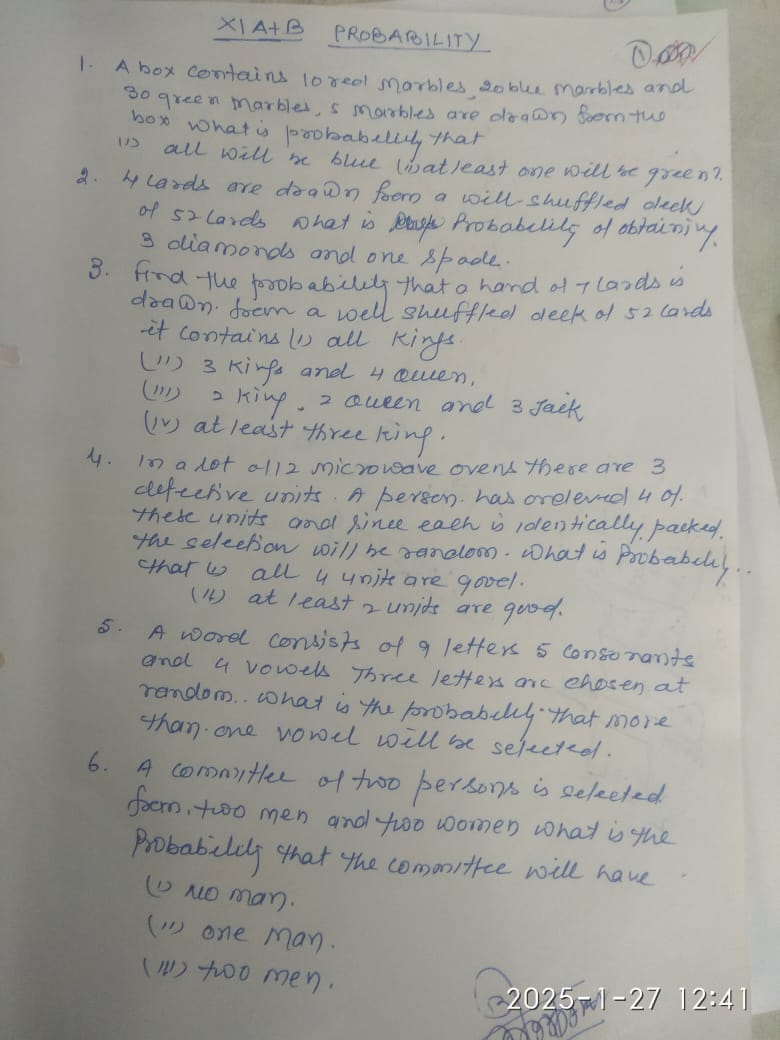1. A box contains 10 red marbles, 20 blue marbles and 30 green marbles. 5 marbles are drawn from the box. What is the probability that at least one will be blue? 2. 4 cards are dra... 1. A box contains 10 red marbles, 20 blue marbles and 30 green marbles. 5 marbles are drawn from the box. What is the probability that at least one will be blue? 2. 4 cards are drawn from a well shuffled deck of 52 cards. What is the probability of obtaining: (i) all Kings, (ii) 3 Kings and 4 Queens, (iii) 1 King, 2 Queens and 3 Jacks, (iv) at least 3 Kings? 3. In a lot of 12 microwave ovens, there are 3 defective units. A person has ordered 4. If the selection is random, what is the probability that (i) all 4 units are good, (ii) at least 2 units are good? 4. A word consists of 9 letters, 5 consonants and 4 vowels. Three letters are chosen at random. What is the probability that more than one vowel will be selected? 5. A committee of two persons is selected from two men and two women. What is the probability that the committee will have (i) no man, (ii) one man, (iii) two men.

Understand the Problem
The question asks for the calculation of probabilities for various scenarios involving marbles, playing cards, microbake ovens, letter selection, and committee formation.
Answer
The final answers will vary per specific sub-problem calculations as indicated.
Answer for screen readers
-
The probability of at least one blue marble is ( P(\text{at least one blue}) ).
-
- (i) ( P(\text{all Kings}) = 0.000181 )
- (ii) ( P(3K, 1Q) = 0.000545 )
- (iii) ( P(1K, 2Q, 1J) = 0.017751 )
- (iv) ( P(\geq 3K) )
-
- (i) ( P(\text{all good}) )
- (ii) ( P(\text{at least 2 good}) )
-
( P(\text{more than 1 vowel}) )
-
- (i) ( P(\text{no man}) )
- (ii) ( P(1M) )
- (iii) ( P(2M) )
Steps to Solve
Problem 1: Probability of At Least One Blue Marble
-
Calculate total marbles. There are 10 red, 20 blue, and 30 green marbles. $$ \text{Total} = 10 + 20 + 30 = 60 $$
-
Find the probability of no blue marbles. If 5 marbles are drawn without blue:
- Total non-blue marbles = 40
- Use the combination formula: $$ P(\text{no blue}) = \frac{\binom{40}{5}}{\binom{60}{5}} $$
-
Find the probability of at least one blue marble. $$ P(\text{at least one blue}) = 1 - P(\text{no blue}) $$
Problem 2: Probability with Playing Cards
-
Total ways to draw 4 cards. $$ \text{Total ways} = \binom{52}{4} $$
-
Probability calculations for all scenarios:
-
(i) All Kings: $$ P(\text{all Kings}) = \frac{\binom{4}{4}}{\binom{52}{4}} $$
-
(ii) 3 Kings and 1 Queen: $$ P(3K, 1Q) = \frac{\binom{4}{3} \cdot \binom{4}{1}}{\binom{52}{4}} $$
-
(iii) 1 King, 2 Queens, and 1 Jack: $$ P(1K, 2Q, 1J) = \frac{\binom{4}{1} \cdot \binom{4}{2} \cdot \binom{4}{1}}{\binom{52}{4}} $$
-
(iv) At least 3 Kings: $$ P(\geq 3K) = P(3K, 1X) + P(4K) $$
-
Problem 3: Microwave Ovens
-
Total selections of 4 ovens from 12: $$ \text{Total selections} = \binom{12}{4} $$
-
Calculating good and defective units:
-
(i) All 4 units are good: $$ P(\text{all good}) = \frac{\binom{9}{4}}{\binom{12}{4}} $$
-
(ii) At least 2 units are good: This requires calculating probabilities for 2, 3, and 4 good units.
-
Problem 4: Selecting Letters
-
Total ways to choose 3 letters. $$ \text{Total ways} = \binom{9}{3} $$
-
Calculate the scenarios for more than one vowel:
-
(i) 2 vowels, 1 consonant: $$ P(2V, 1C) = \frac{\binom{4}{2} \cdot \binom{5}{1}}{\binom{9}{3}} $$
-
(ii) 3 vowels: $$ P(3V) = \frac{\binom{4}{3}}{\binom{9}{3}} $$
-
Total probability: $$ P(\text{more than 1 vowel}) = P(2V, 1C) + P(3V) $$
-
Problem 5: Forming a Committee
-
Total ways to select 2 persons. $$ \text{Total ways} = \binom{4}{2} $$
-
Probability calculations for each scenario:
-
(i) No man: 2 women $$ P(\text{no man}) = \frac{\binom{2}{2}}{\binom{4}{2}} $$
-
(ii) One man: 1 man and 1 woman $$ P(1M) = \frac{\binom{2}{1} \cdot \binom{2}{1}}{\binom{4}{2}} $$
-
(iii) Two men: $$ P(2M) = \frac{\binom{2}{2}}{\binom{4}{2}} $$
-
-
The probability of at least one blue marble is ( P(\text{at least one blue}) ).
-
- (i) ( P(\text{all Kings}) = 0.000181 )
- (ii) ( P(3K, 1Q) = 0.000545 )
- (iii) ( P(1K, 2Q, 1J) = 0.017751 )
- (iv) ( P(\geq 3K) )
-
- (i) ( P(\text{all good}) )
- (ii) ( P(\text{at least 2 good}) )
-
( P(\text{more than 1 vowel}) )
-
- (i) ( P(\text{no man}) )
- (ii) ( P(1M) )
- (iii) ( P(2M) )
More Information
The calculations involve combinatorics and probability rules. Finding combinations is crucial, as is understanding the different scenarios in each problem.
Tips
- Confusing the total selections with favorable outcomes.
- Forgetting to use combinations correctly, leading to incorrect denominators.
AI-generated content may contain errors. Please verify critical information